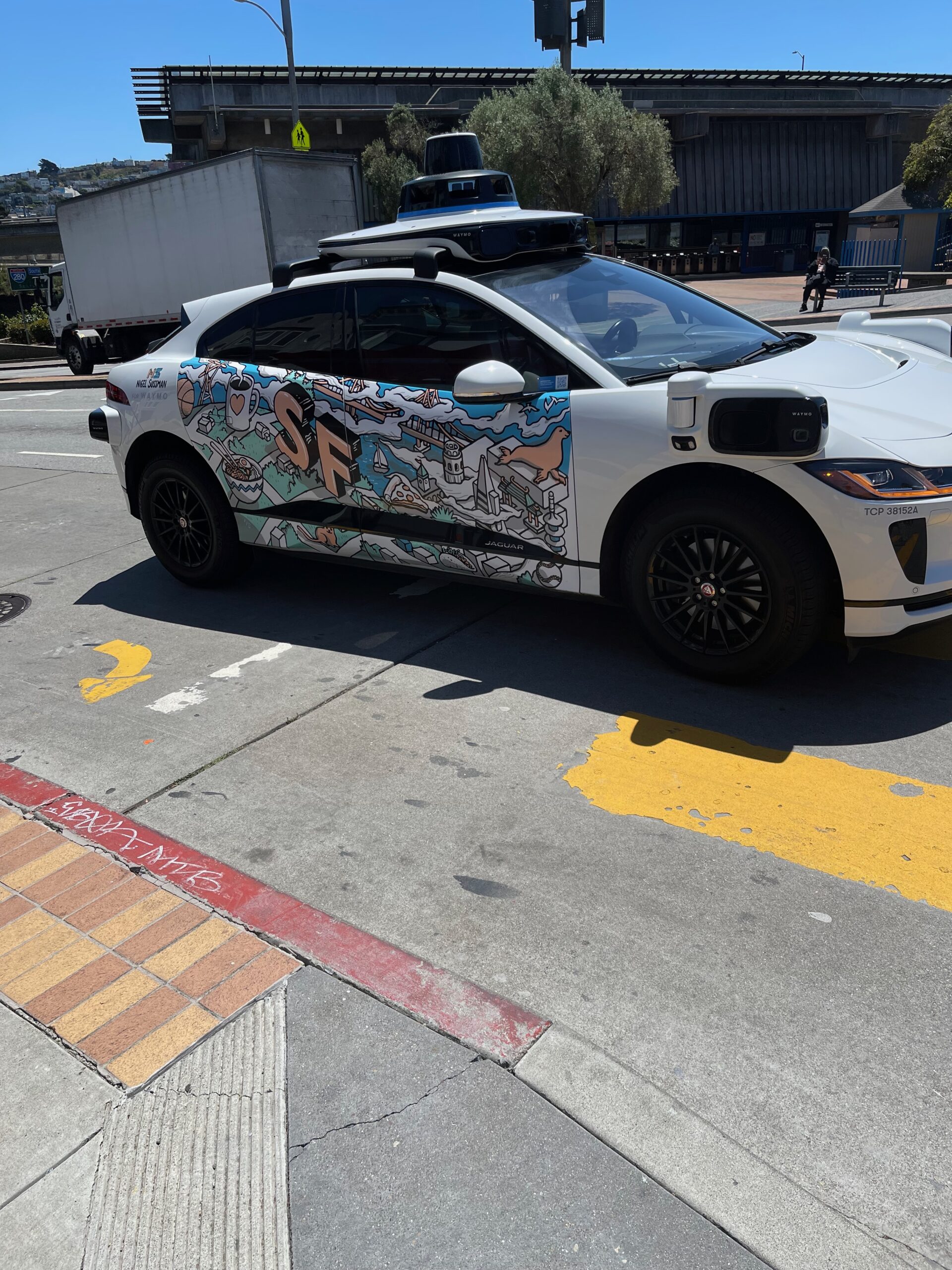Autonomous vehicles (AVs), or Driverless cars, have been testing their performance in San Francisco for many months, at first with drivers at the wheel to trouble shoot. With its steep hills, crowded streets, distracting views, and large numbers of pedestrians, the city is notoriously difficult to drive in, making it a good test ground. That is, good for the profit-making company sponsors, including Google, GM, Amazon and others, but so far, not so great for San Francisco residents.

The AVs went truly driverless just a few weeks ago. In a totally unscientific survey, I asked a group of San Francisco friends what they thought of driverless cars, and whether or not they would ride in a robotaxi. The mixed responses were mostly negative.
Anne R.’s point of view: “Zombie cars are a menace.I was driving on a narrow part of Fulton Street and came upon three vehicles, all double parked/not moving–two large trucks the size of moving vans, and behind them a zombie car. The zombie car did not know what to do and just sat and sat and sat–when I finally moved to pass (my only option being passing in the oncoming lane) the zombie car decided to move. Meanwhile a parked car on the opposite side of the street (parked at a 45- degree angle) started pulling out. Somehow there was not an accident and the zombie car managed to get past the two trucks and, to my great relief, turned left at the next corner.”
Sam O. made this observation: “My one anecdotal encounter was back when Waymo first appeared. I stopped at a stop sign on my bike—I know that stopping makes me an anomaly in San Francisco—and as I moved into the intersection, a Waymo on the cross street started up right at me and then screeched to a stop. That was back when there was a ‘driver’ sitting there and I don’t know whether that person saved me or the car figured it out…”
From Leslie R.: “We don’t need them, period! (It) makes me very nervous to think of cars without drivers! We already have many kinds of cars to use!”
This last point is interesting, because when Uber and Lyft first started offering driving services in the city, the taxi companies were swift to air their opposition. Recently, catching a ride home from the San Francisco International Airport (SFO) in a Flywheel taxi, the driver, a seasoned cab veteran, was philosophical when asked his opinion. “They are here to stay,” was his only comment.
This past month, two companies, Waymo and Cruise, were granted permission by the CPUC (California Public Utilities Commission) to deploy fully autonomous taxi vehicles in the city, which the rider must summon on an app. Although Waymo has voluntarily cut back the number of cars on the streets due to recent accidents, currently 650 driverless cars are approved for taxi use in the city.
City officials not only had no say in the approval of the vehicles, they also have no oversight authority. The rollout has been anything but smooth.
Reactions to the driverless cars by tghe media range from tepid to outrage. A few representative headlines:
“Robotaxis are good for disabled people, advocates say. Are wheelchair users being thrown under the (autonomous) bus?” Editorial by Soleil Ho, San Francisco Chronicle, 8/13/23
“San Francisco’s self-driving car wars intensify after Cruise meltdown,” by Sam Whiting. San Francisco Chronicle, 8/15/23
“A driverless car gets stuck in wet concrete in San Francisco,” by Michael Levenson. New York Times, 8/18/23
Troubles with driverless cars have included blocking intersections, sudden stops, interference with emergency vehicles, a collision with a fire truck, and more. First responders are vocal in their opposition. As noted by NPR, “every second counts in an emergency.” Thank you to Christen R. for sharing this story.
A perhaps slightly tongue in cheek response from Carl R.: In my observations they have all behaved flawlessly. My main objection to them is that they will put cabbies and Lyft and Uber drivers out of work. I might be a little concerned about being unable to explain to a non-human exactly where we want to get out; I’m dubious that they understand mobility issues. But as AI improves, they may even become good conversationalists…”
Nancy B. finds the driverless cars a bit otherworldly: “My first reaction was they are kind of creepy in a ghosty sort of way! Next, they seemed a bit cartoonish and I find myself awaiting a “beep-beep” sound that never arrives. I think if I were in a fender-bender with one, I would be cranky about the absence of someone to deal with. Not sure I will ride in one anytime soon but I’m not against it, so far….I don’t think….Lotsa “what if’s” to ponder.”
It should be noted that driverless cars do not respond to honking, given that there is no one in the driver’s seat to hear it.
Katharine G. is another unequivocal critic: “I don’t want to ride in one! I would find it very stressful. They don’t seem to cope well with the unexpected. And they are ungainly looking – with all their unattractive sensory equipment. SF is crazy to have allowed so many of them to roam our streets.”
Many years ago, I dreamed about one day owning my own personal driverless car. It would take me to where I wanted to go, flawlessly park itself, and be waiting for me when I wanted to travel to my next destination. Maybe that will happen one day, along with flying cars, but likely, I will not be around to see it.
As a pedestrian, I feel safer making eye contact with a human driver, one who acknowledges me while I cross the street. Of course, rogue human drivers are plentiful, and one of the arguments posed to the CPUC by the driverless car developers is that they are safer than relying on humans.
Many years ago, I dreamed about one day owning my own personal driverless car. It would take me to where I wanted to go, flawlessly park itself, and be waiting for me when I wanted to travel to my next destination. Maybe that will happen one day, along with flying cars, but likely, I will not be around to see it.
Like all new inventions, there are flaws in these autonomous vehicles. Early airplanes, submarines, deep sea diving vehicles, rockets to space, etc. have not been immune to accidents either. A key difference, however, is that the risk-takers, for the most part, embraced the risk without endangering unwilling participants.
While the jury may still be out on the need for driverless cars, one thing is clear. They were not ready for prime time when released upon San Francisco.




Gigi Trabant
28 Dec 2023Looking into a car with no driver at the wheel gives. me the creeps… I don’t think I will ever get used to the idea and I would never ride in one. (although never say never?)
Marcia Schneider
29 Dec 2023Thanks, Gigi,k for your comments!!